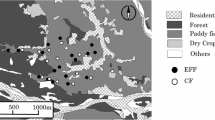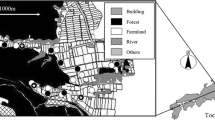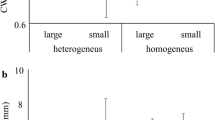Abstract
The paddy field is primarily used as an agricultural system to produce rice, which is the main staple food in Japan. The paddy field plays an important role in the various ecosystem functions such as flood control, groundwater recharge, improvement of water quality, local climate mitigation, fish culture and other non-rice productions, fostering culture and landscape, and maintaining biodiversity, among others. Paddy fields provide an important habitat to foster biodiversity. The remaining rice paddies in urban regions have an important role to alleviate the deterioration of the urban environment.
In the first section, no-tillage cultivation studies carried out so far to investigate its effects on biodiversity in paddy fields are explained. Results show that spiders and carabid beetles prefer no-tillage soils in which the litter accumulate to the soil surface where abundant decomposers exist. Actually, in various types of crops, the density of soil-inhabiting predators such as spiders and carabid beetles is known to be higher in no-tillage or reduced-tillage cultivation field. The results also suggest that predation by spiders (especially lycosid spiders) is an important mortality factor for older larvae of the straight swift, and the effect is greater for the no-tillage paddy fields than the conventional paddy fields.
In the following sections, an integrated rice farming method that uses crossbred ducks being practiced since 150 years ago, known as Aigamo farming in Japanese, is described. The rice-duck farming is a promising technique for producing organic rice in Southeast Asia. The farming system involves organic food certification systems, organic farmers’ cooperatives, community-wide organic farming, localized technical extension and educational services, and integration of farms and rice-duck. An experiment undertaken for the simultaneous cultivation of rice plants and baby crossbred ducks at the university farm in Fuchu, Tokyo, shows the effects of the release of crossbred ducks on the growth and quantities of rice plants, weeds, and diversity of the arthropod community.
Access this chapter
Tax calculation will be finalised at checkout
Purchases are for personal use only
Similar content being viewed by others
References
Bennett AA (1935) Facing the erosion problem. Science 81:321–326
Blumberg AY, Crossley DA Jr (1983) Comparison of soil surface arthropod populations in conventional tillage and old field systems. Agro-Ecosystems 8:247–253
Brust GE, House GJ (1990) Effects of soil moisture, no-tillage and predators on southern corn rootworm (Diabrotica undecimpunctata howardi) survival in corn agroecosystems. Agric Ecosyst Environ 31:199–216
Brust GE, Stinner BR, McCartney DA (1985) Tillage and soil insecticide effects on predator-black cutworm (Lepidoptera: Noctuidae) interactions in corn agroecosystems. J Econ Entomol 78:1389–1392
Brust GE, Stinner BR, McCartney DA (1986) Predator activity and predation in corn agroecosystems. Environ Entomol 15:1017–1021
Cárcamo HA, Nienelä JK, Spence JR (1995) Farming and ground beetles: effects of agronomic practice on populations and community structure. Can Entomol 127:123–140
Chen B, Tojo S, Watanabe K (2003) Machine vision for a micro weeding robot in a paddy field. Biosyst Eng 85(4):393–404
Clark MS, Gage SH, Spence JR (1997) Habitat and management associated with common ground beetles (Coleoptera: Carabidae) in a Michigan agricultural landscape. Environ Entomol 26:519–527
Furuno T (1993) Aigamo Banzai. Rural Culture Association Japan, Tokyo (in Japanese)
Gebhardt MR, Daniel TC, Schweizer EE, Allmaras RR (1985) Conservation tillage. Science 230:625–630
Gilbert M, Xiao X, Chaitaweesub P, Kalpravidh W, Premashthira S, Boles S, Slingenbergh J (2007) Avian influenza, domestic ducks and rice agriculture in Thailand. Agric Ecosyst Environ 119(3–4):409–415
Griffith DR, Mannering JV, Box JE (1986) Soil and moisture management with reduced tillage. In: Sprague MA, Triplett GB (eds) No-tillage and surface-tillage agriculture. Wiley, New York, pp 19–57
Hamada A, Fukui W, Mizushima M (2015) The study of the relationship between connectivity of rural land use and urban fringe area, Kyoto city. J Jpn Soc Reveget Technol 41(1):145–150 (in Japanese)
Hammond RB (1987) Pest management in reduced tillage soybean cropping systems. In: House GJ, Stinner RE (eds) Arthropods in conservation tillage systems. ESA Misc. Publ. No.65. Entomol. Soc. Am., College Park, pp 19–28
Hance T, Gregoire-Wibo C, Lebrum P (1990) Agriculture and ground beetle populations. Pedobiologia 34:337–346
Hasegawa H (1995) Non-tilled rice cultivation. In: Koshihikari. Rural Culture Association, Tokyo, pp 448–454 (in Japanese)
Henning J, Pfeiffer DU, Stevenson M, Yulianto D, Priyono W, Meers J (2016) Who is spreading avian influenza in the moving duck flock farming network of Indonesia? PLoS One 11(3):e0152123
Heong KL, Aquino GB, Barrion AT (1992) Population dynamics of plant- leafhoppers and their natural enemies in rice ecosystems in the Philippines. Crop Prot 11:371–379
Hidaka K (1993) Farming systems for rice cultivation which promote the regulation of pest populations by natural enemies: planthopper management in traditional, intensive farming and LISA rice cultivation in Japan. FFTC Ext Bull 374:1–15
Hidaka K (1997) Community structure and regulatory mechanism of pest populations in rice paddies cultivated under intensive, traditionally organic and lower input organic farming in Japan. Biol Agric Hortic 15:35–49
Hidaka K (1998) Biodiversity conservation and environmentally regenerated farming system in rice paddy fields. Jpn J Ecol 48:167–178 (in Japanese with English abstract)
House GJ, All JN (1981) Carabid beetles in soybean agroecosystems. Environ Entomol 10:194–196
House GJ, Parmelee RW (1985) Comparison of soil arthropods and earthworms from conventional and no-tillage agroecosystems. Soil Tillage Res 5:351–360
Ishijima C, Motobayashi T, Nakai M, Kunimi Y (2004) Impacts of tillage practices on hoppers and predatory wolf spiders (Araneae: Lycosidae) in rice paddies. Appl Entomol Zool 39:155–162
Ishijima C, Taguchi A, Takagi M, Motobayashi T, Nakai M, Kunimi Y (2006) Observational evidence that the diet of wolf spiders (Araneae: Lycosidae) in paddies temporarily depends on dipterous insects. Appl Entomol Zool 41(2):195–200
Itô Y, Miyashita K, Sekiguchi K (1962) Studies on the predators of the rice crop insect pests, using the insecticidal check method. Jpn J Ecol 12:1–12
Kajimura T, Maeoka Y, Sudo T, Hidaka K, Nakasuji F, Nagai K (1993) Effects of organic farming of rice plants on population density of leafhoppers and planthoppers. Jpn J Appl Entomol Zool 37:137–144 (in Japanese with English abstract)
Kaneta Y, Awasaki Y, Yamaya S (1992) Soil management of heavy subsoil for the rotational use of paddy fields. 4 effects of straw application onto soil surface on production methane and growth of rice in the non tillage paddy fielfds. Tohoku Agric Res 45:77–78
Kaneta Y, Awasaki H, Murai Y (1994) The non-tillage rice culture by single application of fertilizer in a nursery box with controlled-release fertilizer. Jpn J Soil Sci Plant Nutr 65:385–391 (in Japanese with English abstract)
Kawahara S, Kiritani K, Kakiya N (1974) Population biology of Lycosa pseudoannulata (Bös. et Str.). Bull Kochi Prefect Inst Agric For Sci 6:7–22
Kendall DA, Chinn NE, Smith BD, Tidbodald C, Winstone L, Western NM (1991) Effects of straw disposal and tillage on spread of barley yellow dwarf virus in winter barley. Ann Appl Biol 119:359–364
Kiritani K (1986) Disturbance and re-stabilization of community. In: Kiritani K (ed) Japanese insect-Ecology of aggression and disturbance. Tokai University Press, Tokyo, pp 158–179
Kiritani K (2010) A comprehensive list of organisms associated with paddy ecosystems in Japan. The Institute of Agriculture and Natural Environment, Itoshima, 60pp
Kiritani K, Hokyo N, Sasaba T, Nakasuji F (1970) Studies on population dynamics of green rice leafhopper, Nephotettix cincticeps Uhler: regulatory mechanism of the population density. Res Popul Ecol 12:137–153
Kiritani K, Kawahara S, Sasaba T, Nakasuji F (1972) Quantitative evaluation of predation by spiders on the green rice leafhopper, Nephotettix cincticeps Uhler, by a sight-count method. Res Popul Ecol 13:187–200
Knipling EF (1992) Principles of insect parasitism analyzed from new perspectives. Practical implications for regulating insect populations by biological means. USDA, Washington, DC, p 337
Koganezawa T (2009) The relationship between rice production and ecosystem services: steps toward sustainable practices. Bull Miyagi Univ Educ 44:15–22
Kumano S, Seki K, Kon T (1985) Studies on puddling in mechanically transplanted rice cultivation. Bull Tohoku Natl Agric Exp Stn 72:1–53 (in Japanese with English abstract)
Landis DA, Bradley JR Jr, Gould F (1987) Behavior and survival of Heliothis zea prepupae in no-tillage and conventional-tillage corn. Environ Entomol 16:94–99
Landis DA, Wratten SD, Gurr GM (2000) Habitat management to conserve natural enemies of arthropod pests in agriculture. Annu Rev Entomol 45:175–201
Li S, Wei S, Zuo R, Wei J, Qiang S (2012) Changes in the weed seed bank over 9 consecutive years of rice–duck farming. Crop Prot 37:42–50
MAFF (2017) Summary of arable land area survey in 2017. http://www.maff.go.jp/j/tokei/kekka_gaiyou/sakumotu/menseki/h29/kouti/index.html
Manda M, Uchida H, Nakagama A, Matsumoto S, Shimoshikiryo K, Watanabe S (1993a) Effects of Aigamo ducks (Crossbred of wild and domestic ducks) herding on weeding and pest control in the paddy fields. Jpn J Poult Sci 30:365–370 (in Japanese)
Manda M, Uchida H, Nakagama A, Watanabe S (1993b) Growth and behavior of Aigamo ducks (crossbred of wild and domestic ducks) in paddy fields. J Poult Sci 30:383–387 (in Japanese)
Maruyama T, Hashimoto I, Murashima K, Takimoto H (2008) Evaluation of N and P mass balance in paddy rice culture along Kahokugata Lake, Japan, to assess potential lake pollution. Paddy Water Environ 6:355–362
Marzluff JM (2001) Worldwide urbanization and its effect on birds. In: Marzluff JM, Bowman R, Donelly R (eds) Avian ecology in an urbanizing world. Klawer, Boston, pp 19–47
Matsumura M (1992) Life table of the migrant skipper, Parnara guttata guttata Bremer et Grey in the northern peripheral area of its distribution. Appl Entomol Zool 27:331–340
Matsuno Y, Nakamura K, Masumoto T, Matsui H, Kato T, Sato Y (2006) Prospects for multifunctionality of paddy rice cultivation in Japan and other countries in monsoon Asia. Paddy Water Environ 4:189–197
McKinney ML (2008) Effects of urbanization on species richness: a review of plants and animals. In: Urban ecosystems. Springer, New York. https://doi.org/10.1007/s11252-007-0045-4
Mori A (2017) Biodiversity and conservation of fish living in paddy field ecosystem. J Rural Plann 35:482–487
Motobayashi T, Ishijima C, Takagi M, Murakami M, Taguchi A, Hidaka K, Kunimi Y (2006) Effects of tillage practices on spider assemblage in rice paddy fields. Appl Entomol Zool 41:371–381
Motobayashi T, Ishijima C, Murakami M, Takagi M, Taguchi A, Hidaka K, Kunimi Y (2007) Effect of spiders on inoculated populations of the migrant skipper Parnara guttata guttata Bremer et Grey in untilled and tilled paddy fields. Appl Entomol Zool 42:27–33
Murata K (1995) The interaction between spiders and prey insects under the sustainable cultivation. Acta Arachnol 44:83–96 (in Japanese with English abstract)
Naganoma H, Kaneta Y, Kodama T (1989) Soil management of heavy subsoil for the rotational use of paddy fields. I. Effect of partial rotary tilling and rice transplanting on soil condition and rice growth. Tohoku Agric Res 42:85–86
Nakasuji F (1982) Population dynamics of the migrant skipper butterfly Parnara guttata guttata (Lepidoptera: Hesperiidae) II. Survival rates of immature stages in paddy fields. Res Popul Ecol 24:157–173
Natuhara Y (2013) Ecosystem services by paddy fields as substitutes of natural wetlands in Japan. Ecol Eng 56:97–106
Nishida K, Senga Y (2004) Influence of environmental factors and paddy field on habitat of freshwater fishes at irrigation channel in an urbanizing area. Trans of JSIDRE 233:29–39 (in Japanese with English abstract)
Nonoyama Y, Yoshizawa T (1976) Studies on the soil management and fertilization method in the non-tilled direct seeding rice culture. 4. Influence of the mineralizing pattern of the soil nitrogen on the growth and yield of rice plant. Bull Chugoku Natl Agric Exp Stn E11:7–51
NRIAE (1998) The result of evaluation of public benefit accompanying agriculture and rural area by a replacement cost method. J Agric Econ 52:113–138 (in Japanese)
Oishi Y, Okubo K, Sasaki K (2012) A review and examination of effective measures for conservation of ecosystem in rice fields. J Fac Agric Shinshu Univ 48:15–22
Okada H, Niwa S, Hiroki M (2016) Nematode fauna of paddy field flooded all year round. Nematol Res 46:65–70
Okatake S (1995) Non-tilled direct seeding rice cultivation in Okayama prefecture. In: Challenge to direct seeding cultivation (vol 3) (Supervision by Kushibuchi K). Japan Association for Techno-innovation in Agriculture, Forestry and Fisheries Tokyo, pp 50–55 (in Japanese)
Oke TR (1987) Boundary layer climates, 2nd edn. Metheun, Lomdon, 435pp
Okuma C (1974) Aeronautic spiders caught by the trap net above paddy fields. Sci Bull Fac Agric Kyushu Univ 29(3):79–85
Omori T, Ono Y, Kawanaka K, Tsuboi I (1970) Soil chemical and nutritional studieson the ploughless planting by punch system sowing of rice and wheat plants in paddy field. I. Influence of the continued ploughless planting on the growth and yield of rice plants and physical and chemical properties of the soils. Spec Bull Okayama Prefect Agric Exp Stn 65:1–18
Paoletti MG (1987) Soil tillage, soil predator dynamics, control of cultivated lant pests. In: Stringanova BR (ed) Soil fauna and soil fertility. Nauka, Moscow, pp 417–422
Riechert SE, Lockley T (1984) Spiders as biological control agents. Annu Rev Entomol 29:299–320
Sakai H, Nonoyama Y, Komoto Y (1968) Studies on the soil management and fertilization method for the unplowing rice culture. I. High-yielding by fertilizer placement. Bull Chugoku Natl Agric Exp Stn E2:193–227
Sato T (1992) The land improvement of paddy field of heavy clay soil by no-tillage farming and prospect for multipurpose paddy field. J JSIDRE 60:723–728 (in Japanese)
Schmidt MH, Roschewitz I, Thies C, Tscharntke T (2005) Differential effects of landscape and management on diversity and density of ground-dwelling farmland spiders. J Appl Ecol 42:281–287
Settle WH, Ariawan H, Astuti ET, Cahyana W, Hakim AL, Hindayana D, Lestari AS (1996) Managing tropical rice pests through conservation of generalist natural enemies and alternative prey. Ecology 77:1975–1988
Sheng F, Cao CG, Li CF (2018) Integrated rice-duck farming decreases global warming potential and increases net ecosystem economic budget in Central China. Environ Sci Pollut Res 25:22744–22753
Shiratani E, Kubota T, Yoshinaga I, Hitomi T (2005) Effect of agriculture on nitrogen flow in the costal water environment at the Ariake Bay. Jpn Ecol Civil Eng 8:73–81
Southwood TRE (1978) Ecological methods. Chapman and Hall, London, 524pp
Stinner BJ, House GJ (1990) Arthropods and other invertebrates in conservation-tillage agriculture. Annu Rev Entomol 35:299–318
Stinner BR, McCartney DA, Van Doren DM Jr (1988) Soil and foliage arthropod communities in conventional, reduced and no-tollage corn systems: a comparison after 20 years of continuous cropping. Soil Tillage Res 11:147–158
Suh J (2015) An institutional and policy framework to foster integrated rice–duck farming in Asian developing countries. Int J Agric Sustain 13:294–307
Sunderland K, Samu F (2000) Effects of agricultural diversification on the abundance, distribution, and pest control potential of spiders: a review. Entomol Exp Appl 95:1–13
Symondson WOC, Glen DM, Wiltshire CW, Langdon CW, Liddell JE (1996) Effects of cultivation techniques and methods of straw disposal on predation by Pterostichus melanarius (Coleoptera: Carabidae) upon slugs (Gastropoda: Pulmonata) in an arable field. J Appl Ecol 33:741–753
Tabuchi T (1998) Science for clean water. Chapter V: Water cycle in watershed (Ed. Water Quality Environment Committee). Jpn Soc Irrigat Drain Reclamat Eng 100–107:115–118 (in Japanese)
Tanaka T, Hamamura T (1968) Population density of spiders in paddy field during winter. Bull College Agric Utsunomiya Univ 7:73–79
Tani M, Hara Y, Sampei Y (2016) Transformation of irrigated agricultural landscapes along with urbanization and its impact to distribution of frog species in Sakai city, Central Japan. Environ Inf Sci 30:237–242
Tashima F, Tatsumoto T, Egashira K (2003) Nitogen balance in the paddy field of the Aigamo-Paddy cultivation. Soil Sci Plant Nutr 74:5–21
Teng Q, Hu XF, Luo F, Cheng C, Ge X, Yang M, Liu L (2016) Influences of introducing frogs in the paddy fields on soil properties and rice growth. J Soils Sediment 16:51–61
Tojo S, Yoshizawa M, Motobayashi T, Watanabe K (2007) Effects of loosing Aigamo ducks on the growth of rice plants, weeds, and the number of arthropods in paddy fields. Weed Biol Manag 7:38–43
Tyubati T, Asano I, Oikawa I (1986) The diagnosis of nitrogen nutrition of rice plants (Sasanishiki) using chlorophyll-meter. Jpn J Soil Sci Plant Nutr 57:190–193 (in Japanese)
Wakasugi K, Fujimori S (2005) Influence that reformation into well-drained paddy field has on the habitation environment of dragonflies, and its measures. J JSIDRE 73:785–788
Wardle DA (1995) Impacts of disturbance on detritus food webs in agro-ecosystems of contrasting tillage and weed management practices. Adv Ecol Res 26:105–182
Way MJ, Heong KL (1994) The role of biodiversity in the dynamics and management of insect pests of tropical irrigated rice – a review. Bull Entomol Res 84:567–587
Westwood JH, Charudattan R, Duke SO, Fennimore SA, Marrone P, Slaughter DC, Swanton C, Zollinger R (2017) Weed management in 2050: perspectives on the future of weed science. Weed Sci 66:275–228
Yokohari M, Brown RD, Kato T, Moriyama H (1997) Effects of paddy fields on summertime air and surface temperatures in urban fringe areas of Tokyo. Jpn Landsc Urban Plan 38:1–11
Yoshizawa M (2000) Effects of releasing crossbreed ducks on the growth of rice plants, weeds, and the number of arthropods in paddy fields. BS thesis, Tokyo University of Agriculture and Technology (in Japanese)
Zheng H, Huang H, Chen C, Fu Z, Xu H, Tan S, She W, Liao X, Tang J (2017) Traditional symbiotic farming technology in China promotes the sustainability of a flooded rice production system. Sustain Sci 12:155–161
Author information
Authors and Affiliations
Corresponding author
Editor information
Editors and Affiliations
Rights and permissions
Copyright information
© 2020 Springer Nature Singapore Pte Ltd.
About this chapter
Cite this chapter
Motobayashi, T., Tojo, S. (2020). Symbiotic Coexistence of Paddy Field and Urban Ecosystem. In: Tojo, S. (eds) Recycle Based Organic Agriculture in a City. Springer, Singapore. https://doi.org/10.1007/978-981-32-9872-9_9
Download citation
DOI: https://doi.org/10.1007/978-981-32-9872-9_9
Published:
Publisher Name: Springer, Singapore
Print ISBN: 978-981-32-9871-2
Online ISBN: 978-981-32-9872-9
eBook Packages: Earth and Environmental ScienceEarth and Environmental Science (R0)




